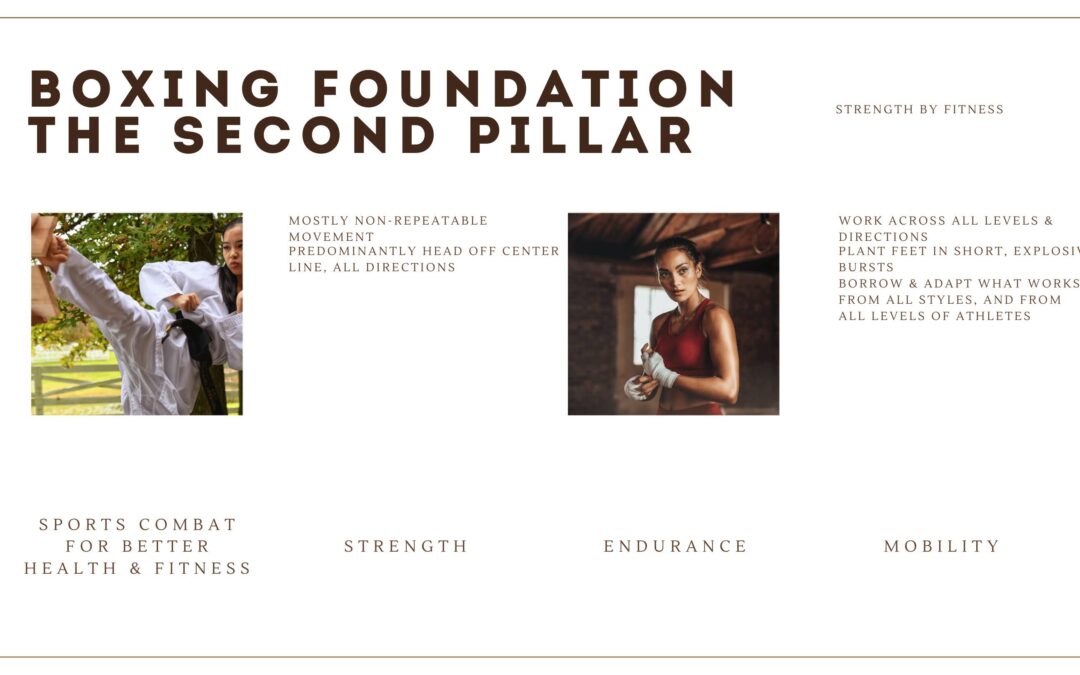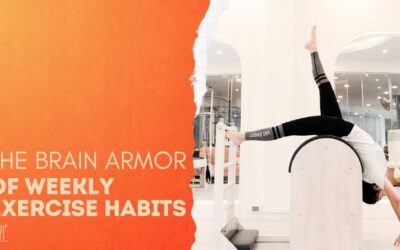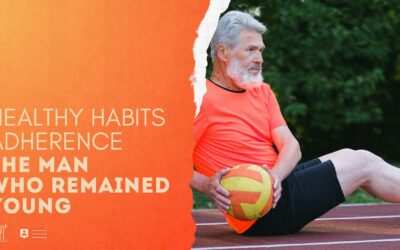Strength By Fitness Exercise Library: Boxing Foundation, The Second Pillar. Movement from head to legs. Every good martial artist needs a good foundation of stackable, intentional movement upon which they can build their offense, and defense. This holds just as true even if you only include weekly sports combat in your fitness life for the fun, and beneficial exercise it happens to be.
Good foundational movement in head, and feet makes for a much better, and more beneficial exercise level for you. While also enabling you to be a vastly better martial artist, and far healthier, and fitter human being. That last thing obviously matters a great deal, especially if you only train for fun, health, and fitness.
Through all parts of Strength By Fitness Boxing Foundation series, you will learn how to move, defend, and box properly, no matter your martial arts preference.
Welcome to Strength By Fitness fact-based fitness life & coaching.
Boxing Foundation.
The 2:nd Pillar.
Movement from head to feet
Check out our other articles in our Boxing Foundation series for a more complete understanding of all the foundational pillars you should work hard to embrace.
Article 1: Hands Up
Combat Sports Pillars: Movement
Mostly non-repeatable movement
Pre-domenantly head off center line, in all directions.
Work across all levels & directions
Plant feet with short, explosive bursts.
Borrow & adapt what works from all styles, and from all levels of athletes.
Some Coach input on the movement pillar: Mostly non-repeatable movement.
No matter what type of movement we are considering, this is a major pillar. Be intentional with your movement, understand how you move, and what every move leads into.
Acknowledge your own pattern, and work deliberately to make your movement pattern predominantly non-repetitive.
Yes, this applies to feet, head, kicks, punches, blocks, guard, knees, and elbows too. Ít applies to everything you can do in martial arts, including submissions, wrestling, sweeps, throws, as well.
This intentional habit will make you that much harder to read, trap, and counter. Once this is an established habit, you can then start feinting and laying traps by deliberately repeating some movement.
At your own choosing.
Even tho I am a very fit man, and always keep in shape, this has always been my real superpower in martial arts, and most other competitive team sports I have ever done.
Once you are cognitively on top of your own movement patterns, you will see everybody else’s movement so clearly, too.
Most importantly, I am making this a major pillar for you because most martial artists, even high-level pro fighters, and far too many coaches repeat the same movement all the time.
How often do you not see the same world-class fighters in UFC, and One take their head off the center line in the exact same way every time they punch? Be it a jab, cross, hook, overhand, uppercut, or something else.
And if you are doing the same thing all the time, is there any real, higher-level purpose to it? No, because at that point, it’s not protective at all, because it’s not hard to pick up on or see at all.
It´s a sloppy and lazy way to go about it.
A harsh truth, maybe, but if this is you, the only reason you are getting away with it is because most people are quite terrible at reading other people’s movement patterns. Even amongst pro fighters in One and UFC.
So it’s basically pure luck for you, and a lack of skills from your opponents.
Don’t be that guy who relies on luck and others’ lacklustre skills, build proper habits and outclass even the best of your opponents instead.
Thus, we have the next movement pillar.
Pre-dominantly head off the center line, in all directions.
Don’t take your head off center in the same way on every single punch you throw. 99% of fighters that do take their head off center dip their head in the exact same way, and direction, every single strike off that hand.
Don’t do that.
If you are throwing a jab or a cross with your right hand. Learn to take your head off the center line, most of the time, but not always.
Sometimes striking behind your hands is the right thing to do, simply because, most of the time, you will take your head off that center line. And we do not want to always repeat the same thing.
Not to mention, a higher-level opponent will expect you to always take your head off the center line.
Instead, what you want to make your opponents do is to force them into second-guessing everything that will happen once you throw your first punch, or kick, or whatever it is they see you do.
So, as you throw that right jab or cross, move your head left at times, right at other times, and sometimes, keep it in the center line. Yes, it’s less safe to work behind that center line, and to move your head to the right is less safe too, and with less room for error since you are left with less range of motion going in that direction after a jab or cross with your right hand.
But now you have a minimum of 3 directions for your head, off of every single punch you throw.
Build on this by adding bobs, and dips, and cutting angles too, and do it all in several different ways, even the ones you are supposed to “never do”, and your opponent will have next to no way to predict accurately where that juicy head of yours ( legs, or body ) will be going.
Build a cognitively based, and stackable movement system that´s completely dynamic.
What do I mean when I say, build a cognitively based, and stackable movement ? Thats contextual of course.
But the two YouTube videos I included, down below, from Jeff Chan MMA, and Ben Woolliss makes for a fairly good example.
Always have a good intent, and purpose with every movement you are chosing to do, and always have a follow up you can build with from your own, and your opponents movements too.
And dont repeat the same pattern perpetually.
Build the opponents reaction and change the follow up. Intelligent and stackable, this will allow you to dynamically change movement patterns on the spot, and that builds really good outcomes in martial arts.
Combat Sports Pillars: Movement
Mostly non-repeatable movement
Pre-domenantly head off center line, in all directions.
Work across all levels & directions
Plant feet with short, explosive bursts.
Borrow & adapt what works from all styles, and from all levels of athletes.
Work across all levels & directions
Now, what does this mean?
It´s as simple as it sounds. When you move, be it in a defensive or offensive way. Embrace the same approach as the omnidirectional way you are now taking your head off the center line.
Slip those high guard hands into your opponent’s body, punch to the tummy, to the face, straight ones, hooks, uppercuts, and the occasional overhand too. Do not become predictable in your striking. Work across all vertical levels, punch and box from all directions, all types of punches, and from all angles.
Also, learn to cut the angle as you strike, switch from orthodox to southpaw mid combo, slip and move from left to right as you kick and punch, move forward, backwards, and in circles.
Kick from head to feet, and learn to kick equally well, and often with both legs, no matter position, and movement, don’t limit yourself. Learn to break the expected movement patterns and rules and turn the basics of movement into a superpower.
Do everything with all limbs, strike, and move in all directions, and all vertical levels, making use of all angles.
Plant feet with mostly short, explosive bursts.
This one refers to you becoming combat sports fit and skilled enough to move with light, yet explosive bursts of feet, legs, and body movements. We talked about this in our first combat sports article in our foundational pillar series. But in article 2, we are going to focus on that moment when your light, perpetual movement turns into that explosive, rapid movement of striking, and you go from bouncing and light to planting your feet to gain balance and more power.
This is a dynamic, and transitional phase, meaning you shouldn’t always plant your feet, because that makes you a slower, less mobile target, and that makes it easier to figure you out, and land good, solid, clean hits on you.
Neither should you linger around overly long when you do plant your feet, for the same reasons.
And yes, of course, you can kick, elbow, punch, and knee without planting your feet. And you should master that too.
Both styles of striking have their fair use, and there are specialized fighters of both styles making good pro careers in the biggest promotions.
With that said, since both planting your feet and being mobile work very well, even at the highest pinnacle of combat sports, doesn’t that make a very appealing case for mastering both and becoming fluent, smooth, and perpetual in how you implement both aspects into your own striking game?
I know that for me, the choice is obvious: do both, master them well, and become truly fluent and adaptable. That’s what I do.
When needed and possible to get away with, I plant my feet and bang away. And when it’s beneficial, or even essential to be perpetually mobile and strike as you move, that’s what I do, and I effortlessly transform between these two stances as the session goes on. Just as how I flow between southpaw, squared, and orthodox, and kick with both legs no matter position, or stance.
Now, as with everything else in combat sports, this is a step-by-step process.
You progress and grow over the years and decades.
So start from A and make use of what fits your personal style and skill level right in the now, and work on expanding and improving your game, trying to become a more complete fighter.
Borrow & adapt what works from all styles, and from all levels of athletes.
This is the easiest but quite possibly the most beneficial pillar you can embrace right from day one.
Too many are focused on styles and schools, and a “you have to do it like this” kind of mentality.
Do not limit yourself like that.
Enjoy all martial arts, from boxing to traditional karate styles like Shotokan, learn from Tae Kwon Do, embrace wrestling in all its forms, borrow techniques and ideas from Judo, Brazilian Jiu-Jitsu, take what’s good from all the Muay Thai styles, kickboxing, MMA, russian wrestling, Chinese Kung Fu, and so on.
Every style, teacher, and athlete is an opportunity to learn from. So, borrow from the entire world of combat sports and martial arts, embrace what works for you and make it part of your style, familiarise yourself with what doesn’t make the cut, just so you understand how those techniques will be applied.
Master the fundamentals, the basic stuff will never go out of style, because it works.
You only need an amazing jab, and cross, a front kick, a 45/roundhouse kick, a side kick, and a spinning back kick to dominate any fight. So master these basics and never disregard them, but perpetually expand upon that and borrow everything fancy or weirdly wild that works for you and makes for a good fit to how you fight and move at your best.
Finally, I am not talking about you having to formally train in all of these sports.
There is no need for that.
Formally train the ones you like, even if that’s just one or two.
If you pick just one formal martial arts, be modern and go straight for MMA, it’s the most versatile foundation to learn if you have no prior experience since its made up of most of the others.
But, do not underplay the benefit of watching pro fighters compete, you don’t have to learn everything by travelling to someone or by signing up at their personal dojo/gym. Watch their official fights and emulate the bits that work for you.
Invite local fighters from other styles, spar, and train together. Holding a belt is fun, but it has no real-life value by itself.
It’s the skill and knowledge you learned on the way to that belt that matters.
As such, expand perpetually on that personal skill, and knowledge level no matter if that is a formal training circumstance, or not.
Likewise, don’t be afraid of joining a local combat sports gym when travelling. Make it an active vacation and learn new things. Read books, watch instructional videos on YouTube. And don’t just watch the popular current day athletes, learn from the old masters and fighters too.
From Benny the Jet to Bill Superfoot, old aikido principles, muhammed ali, Mike Tyson, and the reigning current day fighters, greats, and champions.
Take a peek at the often injured and now retired UFC fighter Dominick Cruz; at his peak, his movement and fighting style were a blast.
Plenty to learn from that. For most people.
Also borrow ideas from some of Thailand’s greatest fighters, both old and current ones, as well as the countless of amazing martial artists who don’t fight professionally, and doesnt publish online videos. Be open minded and pick the best of the best from every source you encounter.
Sports combat is one of our aerobic fitness options in all of our public, and private fitness plans.
At Strength By Fitness we make use of sports combat as a fun, and beneficial regular aerobic fitness option. You can run, row, skii, skate, bike or climb in stead. But combat sports is a severely underrated aerobic exercise choice.
You do not have to train martial arts in a proper martial arts gym to benefit from this wonderful exercise modality. You can find jump straight into weekly strength training, running and combat sports by clicking on the link down below.
Related content
Outdoor/bodyweight fitness plan
Boxing Foundations. Article 1: Hands Up
recent articles
The Brain Armor of Weekly Exercise.
Body and brain walk hand in hand. As such, regular, weekly exercise boosts both the physical and cognitive you. Making you faster, fitter, stronger and more durable, while, also drastically improving health, processes, and function in body & brain.
Fitness Hike, Weighted Calisthenic, Yoga and Coaching
Participate in our unique weighted Fitness Hike + Personalized Coaching Talk together with Strength By Fitness, on location in gorgeous Cape Town, South Africa. Or get the same coaching while doing weighted calisthenics, yoga or boxing.
Type II Diabetes: How Fitness and Nutrition Can Mitigate and reverse t2d. Exclusive Member Article.
IF you want to prevent type 2 diabetes, or reverse it, if the damage has already been done, as it has for hundreds of millions of people around the world, you have three massively powerful and influential habits at your disposal. Welcome to another fact-based member-exclusive Strength By Fitness article.
Members & Clients Recipe: Tofu, dates & orange smoothie. High SPC & Protein.
Our Tofu, dates & orange smoothie provides 56g of Protein, 22g of fiber, and a very high SPC between 66 & 80. That makes this another tasty Strength By Fitness winner. Paid Reader & Client Exclusive Recipe.
Quality Sleep Is Just Another Habit.
Quality sleep comes from a few key pillars in a healthy lifestyle.
Yes, quality sleep is just another habit we build over time with nothing more than our own choices. In this article, Coach Mike from Strength By Fitness will teach you how to do it too.
The Man Who Remained Young. Healthy Habits vs Ageing: Exclusive Member Article.
Strength training, injury-free, 80-year-old men can be as strong as a 35-year-old gym goer. And running is no different. All it takes are maintained habits. Exclusive Strength By Fitness Member Article. Join today, only 9$ Per Year.
We appreciate you
so stay healthy & never stop training
Contact
Private In-App Messaging is Available For All App + Coaching Clients
Adress
Coaching Is Available Online Via App on IOS & Google Play, and In-person, On-location.






